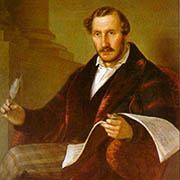The tragedia lirica “Caterina Cornaro” by Gaetano Donizetti was performed for the first time on 18 January 1844 in the Teatro San Carlo, Naples. More than 170 years later, it is published for the first time in an authoritative edition.
Donizetti’s tragedia lirica Caterina Cornaro was premiered on 18 January 1844 in the Teatro San Carlo in Naples. In 15th century Venice, the marriage between Caterina and Gerardo is suspended in favour of Lusignano, King of Cyprus, who intends to marry Caterina. Her refusal would mean the assassination of Gerardo. Made to believe that she doesn’t love him anymore, Gerardo departs under death threats, cursing the day that he met her. In Cyprus, the Venetian ambassador Mocenigo (who plots to bring the island under Venetian rule) tries to kill Gerardo. But Lusignano, poisoned by Mocenigo and in a weakening condition, prevents the assassination. The Venetians will soon attack Lusignano’s kingdom. Gerardo, who has joined the Knights Hospitallers at Rhodes, comes to defend him. Mortally wounded, the King dies, and entrusts the care of his people to Caterina.
The work was originally conceived in 1842 for Vienna’s Kärntnertortheater, but was shelved when a similarly titled opera by Franz Lachner was performed there in November of that year.
With a commission from Naples for a new opera based on Victor Hugo’s Ruy Blas, and time running short due to several other obligations, Donizetti proposed completing the half-finished opera for the San Carlo. The directors of the theatre did not respond to his suggestion with enthusiasm, but Donizetti was not deterred by their adverse reactions. In a letter to librettist Sacchèro (March 1843) he asks for his help, while requesting the words for “a vigorous cabaletta for the entrance of the King”, as well as the introduction of the chorus in the quartet, and a duet between Caterina and Lusignano at the beginning of the third act, among other additions. Although not all of his requests were honoured, the composition was finished in June 1843 and dispatched to Naples.
Donizetti was highly concerned about the prima donna who would sing the title role, and suggested postponing the premiere until a soprano was found “who may please greatly”. Of the two possible contenders, Anna Bishop and Fanny Goldberg, Donizetti clearly preferred the latter, “if there’s no one better […] since Mme Bishop hasn’t much voice”.
Owing to bad health, Donizetti was not able to travel to Naples and produce the opera, as was common practice. Instead he recommended asking Mercadante “if any difficulties were to arise during rehearsals, if something were not well orchestrated, or were too weak, or too loud, to help me as if it were his own music”. Despite his trouble, the opening night was a failure: only three items from the entire score were applauded. A newspaper stated that “Donizetti had neglected the composition, had filled his score with reminiscences, had tossed off an inferior work, […] that the work was not his at all”. The fiasco led to Donizetti’s decision not to compose for Naples any more. But, not having lost faith in his opera, he decided to revise some items for a revival in Parma in February 1845, with his much-preferred baritone Felice Varese. Ill and overworked, Donizetti’s modifications were not as extensive as he intended. He did, however, work out one important revision for the opera’s finale: he replaced Caterina’s cabaletta (which had received no applause in Naples) with a dying scene for Lusignano. It is possible, however, that this revision reached the theatre too late, and that it was not performed.
The new critical edition by Bärenreiter-Verlag is the first modern edition of this opera. It presents the work as it was premiered in Naples, and indicates, where possible, the revisions made for Parma. Its whereabouts long unknown, the alternative finale is given in an appendix, making it widely available for the very first time. The edition is accompanied by an extensive critical commentary which explains and clarifies the different layers in the compositional process as much as possible.
Hans Schellevis
(from [t]akte 1/2018)



